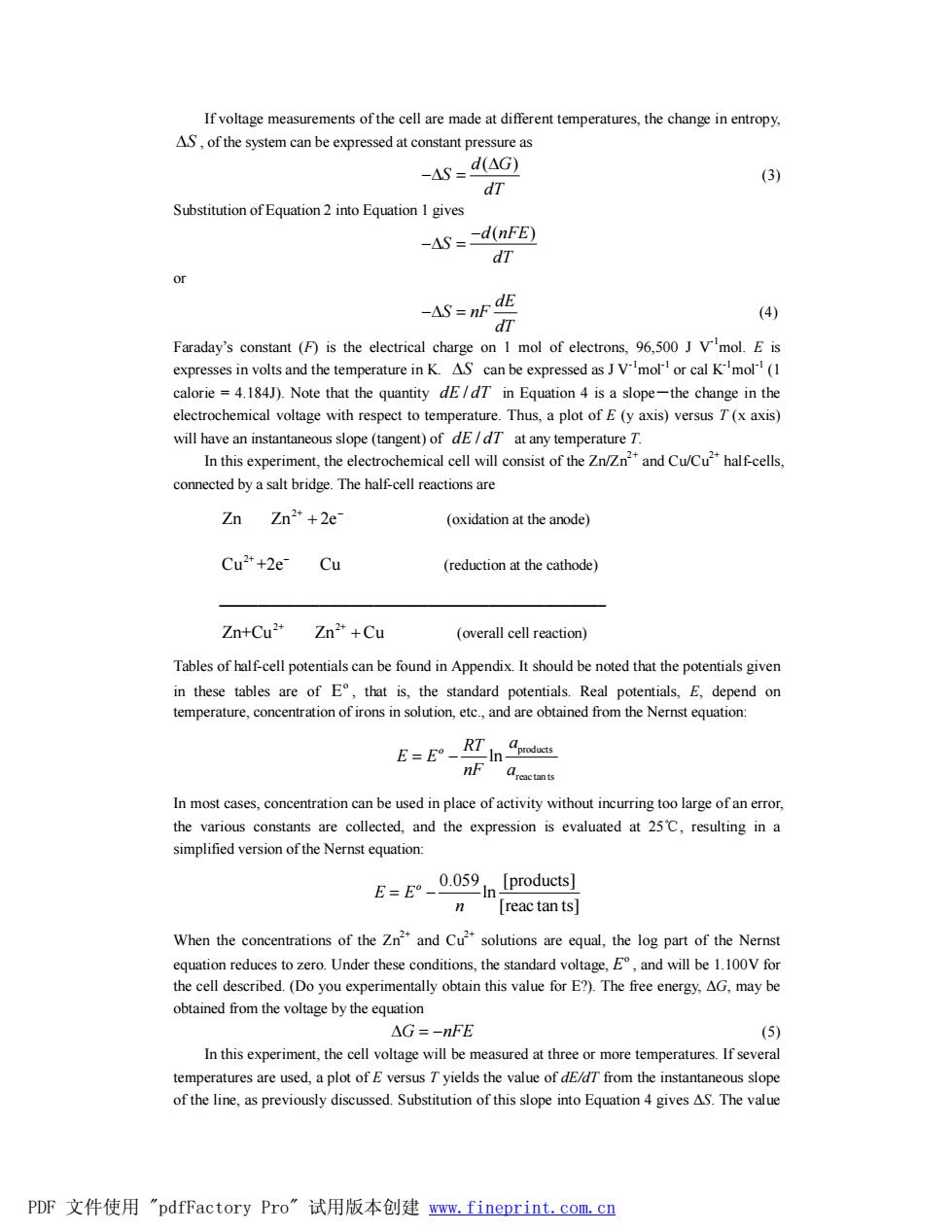正在加载图片...

Ifvoltage measurements of the cell are made at different temperatures,the change in entropy. AS. of the system can be expressed at constant pressure as -4S=d4G) (3) dT Substitution of Equation 2 into Equation I gives -AS=-d(nFE) -AS=nF dE (4) Faraday's constant (is the electrical charge on 1 mol of electrons 96 500 I Vmol E is express olts and the t em perature in K.AS an he expressed as calKmol(1 calorie =4.184J).Note that the quantity dE/dT in Equation 4 is a slope-the change in the electrochemical voltage with respect to temperature.Thus,a plot of E(y axis)versus 7(x axis) will have an instantaneous slope(tangent)of dE/dT at any temperature T. In this experiment,the electrochemical cell will consist of the Zn/nand Cu/Cuhalfcells. connected by asalt bridge.The half-cell reactions are Zn Zn*+2e (oxidation at the anode) Cu"+2e- Cu (reduction at the cathode) Zn+Cu2 Zn2+Cu (overall cell reaction) Tables of half-cell potentials can be found in Appendix.It should be noted that the potentials given in these tables are of E that is.the standard potentials.Real potentials.E.depend on temperature,concentraionof irons in solution etcand are obtained from the Nernst quation nF In most cases,concentration can be used in place of activity without incurring too large of an error. the various constants are collected,and the expression is evaluated at 25C,resulting in a simplified version of the Nernst equation: n [reac tan ts] When the concentrations of the Znand Cusolutions are equal,the log part of the Nernst deredrdnd be 1.100V the cell described.(Do btai tree energy △G,may be △G=-nFE ( In this experiment,the cell voltage will be measured at three or more temperatures.If several temperatures are used,a plot of E versus Tyields the value of dE/dT from the instantaneous slope of the line,as previously discussed.Substitution of this slope into Equation 4 gives AS.The value PDF文件使用"pdfFactory Pro”试用版本创建ww,fineprint.com,cnIf voltage measurements of the cell are made at different temperatures, the change in entropy, DS , of the system can be expressed at constant pressure as d G ( ) S dT D -D = (3) Substitution of Equation 2 into Equation 1 gives d( ) nFE S dT - -D = or dE S nF dT -D = (4) Faraday’s constant (F) is the electrical charge on 1 mol of electrons, 96,500 J V-1mol. E is expresses in volts and the temperature in K. DS can be expressed as J V-1mol-1 or cal K-1mol-1 (1 calorie = 4.184J). Note that the quantity dE / dT in Equation 4 is a slope-the change in the electrochemical voltage with respect to temperature. Thus, a plot of E (y axis) versus T (x axis) will have an instantaneous slope (tangent) of dE / dT at any temperature T. In this experiment, the electrochemical cell will consist of the Zn/Zn2+ and Cu/Cu2+ half-cells, connected by a salt bridge. The half-cell reactions are 2+ Zn Zn 2e- + (oxidation at the anode) 2+ Cu +2e Cu - (reduction at the cathode) __________________________________________________ 2+ 2+ Zn+Cu Zn +Cu (overall cell reaction) Tables of half-cell potentials can be found in Appendix. It should be noted that the potentials given in these tables are of o E , that is, the standard potentials. Real potentials, E, depend on temperature, concentration of irons in solution, etc., and are obtained from the Nernst equation: products reac tan ts ln o RT a E E nF a = - In most cases, concentration can be used in place of activity without incurring too large of an error, the various constants are collected, and the expression is evaluated at 25℃, resulting in a simplified version of the Nernst equation: 0.059 [products] ln [reac tan ts] o E E n = - When the concentrations of the Zn2+ and Cu2+ solutions are equal, the log part of the Nernst equation reduces to zero. Under these conditions, the standard voltage, o E , and will be 1.100V for the cell described. (Do you experimentally obtain this value for E?). The free energy, ΔG, may be obtained from the voltage by the equation DG = -nFE (5) In this experiment, the cell voltage will be measured at three or more temperatures. If several temperatures are used, a plot of E versus T yields the value of dE/dT from the instantaneous slope of the line, as previously discussed. Substitution of this slope into Equation 4 gives ΔS. The value PDF 文件使用 "pdfFactory Pro" 试用版本创建 www.fineprint.com.cn